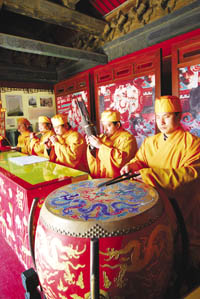| Tools: Save | Print | E-mail | Most Read |
| Hidden Gem |
| Adjust font size: |
Zhihuasi was built in 1443 during the eighth year of the reign of Ming dynasty Emperor Yingzong, when it was given the name Bao'en Zhihuasi. The year before that, a trusted eunuch of Yinzong's, named Wang Zhen, had been placed in charge of the Ministry of Rites. He soon developed a reputation for conducting vicious political smear campaigns against his foes as he grabbed power and influence. With money he embezzled from the public, Wang built up the compound as an ancestral hall for his family while continuing his corrupt ways. The party didn't last long, however. In 1449, Mongol forces invaded Ming territory. Wang Zhen, who had virtually no military experience, advised his master to lead a doomed campaign against the invaders, but the result was a hasty retreat and disastrous detour through the eunuch's hometown of Tumubao in Furious with the failings of his elder brother's most trusted official, the interim Emperor Daizong ordered the slaying of Wang Zhen's entire family. But when Yingzong recaptured the throne after his unexpected release (and a brutal brotherly bloodbath), he held honorary rites for his fallen servant in the temple and erected a statue of him in the grounds. Nearly 300 years later, during the reign of Qing dynasty Emperor Qianlong, the statue of the scheming eunuch was finally replaced by a gleaming golden Buddha and the temple was converted into the place of worship it is today. Once inside the temple grounds visitors are greeted by the Hall of Wisdom and Cultivation, where 15-minute performances of Jingyue are given by a group Buddhist musicians (the 28th generation of musicians to play on the grounds) each day at 9am, 10am, 11am and 3pm. Behind the hall are three additional buildings: the Zang Dian (Scriptures Hall) to the left; the Dazhi Dian on the right; and in the middle, the Zhihua Dian (Zhihua Hall), with its unique, floor-to-ceiling Ming dynasty rotating scripture cabinet. At the rear of the complex lies the Tathagata Hall (Da Zang Ge), located downstairs from the Myriad Buddha's Pavilion (Wan Fo Ge). Herein lies a wooden version of the Long Zang Jing Ban, one of only two remaining Chinese versions of this priceless Buddhist scripture in the world. The walls of the two-story hall are also adorned with 9,999 hollowed-out niches, each containing intricately carved small statues of Buddha. The old caisson ceiling was dismantled in the 1930s and taken to Also in the area From Zhihuasi, go north along Chaoyangmen Nanxiaojie and along the western side of the road until you reach Neiwu Bujie. Formerly known as Goulan Hutong during the Ming and Qing dynasties, it was home to the administrative seat for the Department of Internal Affairs during the Republican era -hence the name, which literally translates as "Department of Internal Affairs" street. Today, this area just east of bustling Dengshikou is filled with a selection of shops and restaurants, as well as the former residence of the poet Liang Shiqiu at 30 Neiwu Bujie. Aside from helping establish the influential periodical Xinyue in 1928, Liang is perhaps best known as an adversary of the writer Lu Xun and a vocal critic of the literary realism he advocated. After you hit Neiwu Bujie, walk back to Chaoyangmen Nanxiaojie and go north two blocks until you see Lishi Hutong on your left. Back in the Ming dynasty, this alley was called L¨¹shi Hutong because it was the site of a donkey and mule market. The market was closed down in the late Qing dynasty and the name was changed to the similar-sounding Lishi Hutong. At the western end of the hutong lie courtyards 129 and 130, which were both part of the former residence of Liu Luoguo, a prime minister who served during the reign of Qing dynasty Emperor Qianlong. Famous for his anti-corruption campaigns, Liu was an adversary of the Rasputin-like eunuch Heshen, a favorite of Qianlong's and one of the most corrupt officials in Chinese history. After years of bitter struggle, Liu finally managed to send Heshen to the gallows, thus ending his reign of terror. Today the residence is owned by a recording company, but can still be viewed from the outside. Grab a bite Jinbaojie Canting is a Muslim restaurant located at the end of Xiaopaifang Hutong, adjacent to Zhihuasi. For chain mavens, there is a Shangdao Cafe just across the street. Getting there: Take bus 24, 713 to Lumicang or Subway Line 2 to Chaoyangmen and go out of Exit B. Walk straight until you reach the entrance to a small hutong on your right, which will lead you to Xiaopaifang Hutong. Ticket: 20 yuan Opening hours: 8:30 – 16:30 Add: 55 Lumicang Hutong, Dongcheng District (6525 0072) (That’s
|
| Tools: Save | Print | E-mail | Most Read |
 |
| Related Stories |
|
|
Product Directory China Search |
Country Search Hot Buys |
